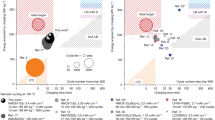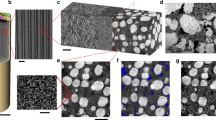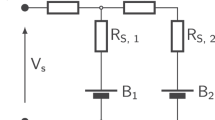Abstract
Electric vehicles demand high charge and discharge rates creating potentially dangerous temperature rises. Lithium-ion cells are sealed during their manufacture, making internal temperatures challenging to probe1. Tracking current collector expansion using X-ray diffraction (XRD) permits non-destructive internal temperature measurements2; however, cylindrical cells are known to experience complex internal strain3,4. Here, we characterize the state of charge, mechanical strain and temperature within lithium-ion 18650 cells operated at high rates (above 3C) by means of two advanced synchrotron XRD methods: first, as entire cross-sectional temperature maps during open-circuit cooling and second, single-point temperatures during charge–discharge cycling. We observed that a 20-minute discharge on an energy-optimized cell (3.5 Ah) resulted in internal temperatures above 70 °C, whereas a faster 12-minute discharge on a power-optimized cell (1.5 Ah) resulted in substantially lower temperatures (below 50 °C). However, when comparing the two cells under the same electrical current, the peak temperatures were similar, for example, a 6 A discharge resulted in 40 °C peak temperatures for both cell types. We observe that the operando temperature rise is due to heat accumulation, strongly influenced by the charging protocol, for example, constant current and/or constant voltage; mechanisms that worsen with cycling because degradation increases the cell resistance. Design mitigations for temperature-related battery issues should now be explored using this new methodology to provide opportunities for improved thermal management during high-rate electric vehicle applications.
This is a preview of subscription content, access via your institution
Access options
Access Nature and 54 other Nature Portfolio journals
Get Nature+, our best-value online-access subscription
$29.99 / 30 days
cancel any time
Subscribe to this journal
Receive 51 print issues and online access
$199.00 per year
only $3.90 per issue
Buy this article
- Purchase on Springer Link
- Instant access to full article PDF
Prices may be subject to local taxes which are calculated during checkout





Similar content being viewed by others
Data availability
Correspondence and requests for materials should be addressed to the corresponding author, P.R.S.
References
Spinner, N. et al. Novel 18650 lithium-ion battery surrogate cell design with anisotropic thermophysical properties for studying failure events. J. Power Sources 312, 1–11 (2016).
Yu, X. et al. Simultaneous operando measurements of the local temperature, state of charge, and strain inside a commercial lithium-ion battery pouch cell. J. Electrochem. Soc. 165, A1578 (2018).
Kok, M. et al. Virtual unrolling of spirally-wound lithium-ion cells for correlative degradation studies and predictive fault detection. Sustainable Energy Fuels 3, 2972–2976 (2019).
Ziesche, R. F. et al. 4D imaging of lithium-batteries using correlative neutron and X-ray tomography with a virtual unrolling technique. Nat. Commun. 11, 777 (2020).
Sripad, S., Bills, A. & Viswanathan, V. A review of safety considerations for batteries in aircraft with electric propulsion. MRS Bull. 46, 435–442 (2021).
Li, M. et al. Fast charging lithium-ion batteries for a new era of electric vehicles. Cell Rep. Phys. Sci. 1, 100212 (2020).
Tomaszewska, A. et al. Lithium-ion battery fast charging: a review. eTransportation 1, 100011 (2019).
Griffith, K. J. et al. Niobium tungsten oxides for high-rate lithium-ion energy storage. Nature 559, 556–563 (2018).
Billaud, J. et al. Magnetically aligned graphite electrodes for high-rate performance lithium-ion batteries. Nat. Energy 1, 16097 (2016).
Lain, M. & Kendrick, E. Understanding the limitations of lithium ion batteries at high rates. J. Power Sources 493, 229690 (2021).
Ma, S. et al. Temperature effect and thermal impact in lithium-ion batteries: a review. Progr. Nat. Sci. Mater. Inter. 28, 653–666 (2018).
Finegan, D. et al. Tracking internal temperature and structural dynamics during nail penetration of lithium-ion cells. J. Electrochem. Soc. 164, A3285 (2017).
Han, A. et al. Effect of humidity on properties of lithium-ion batteries. Int. J. Electrochem. Sci. 16, 210554 (2021).
Hagart-Alexander, C. in Instrumentation Reference Book 4th edn (ed. Boyes, W.) Ch. 21, 269–326 (Elsevier, 2010).
Houx, J. L. & Kramer, D. X-ray tomography for lithium ion battery electrode characterisation—a review. Energy Rep. 7, 9–14 (2021).
Petz, D. et al. Lithium distribution and transfer in high-power 18650-type lithium-ion cells at multiple length scales. Energy Storage Mater. 41, 546–553 (2021).
Xu, C. et al. Future material demand for automotive lithium-based batteries. Commun. Mater. 1, 99 (2020).
Ding, Y. et al. Automotive lithium-ion batteries: current status and future perspectives. Electrochem. Energ. Rev. 2, 1–28 (2019).
Heenan, T. et al. Identifying the origins of microstructural defects such as cracking within Ni-rich NMC811 cathode particles for lithium-ion batteries. Adv. Energy Mater. 10, 2002655 (2020).
Finegan, D. et al. Spatially resolving lithiation in silicon–graphite composite electrodes via in situ high-energy X-ray diffraction computed tomography. Nano Lett. 19, 3811–3820 (2019).
Maleki, H. et al. Thermal properties of lithium-ion battery components. J. Electrochem. Soc. 146, 947 (1999).
Tranter, T. et al. Communication—prediction of thermal issues for larger format 4680 cylindrical cells and their mitigation with enhanced current collection. J. Electrochem. Soc. 167, 160544 (2020).
Offer, G. et al. Cool metric for lithium-ion batteries could spur progress. Nature 582, 485–487 (2020).
Heenan, T. M. M. et al. Data for an advanced microstructural and electrochemical datasheet on 18650 Li-ion batteries with nickel-rich NMC811 cathodes and graphite-silicon anodes. Data Brief. 32, 106033 (2020).
Vaughan, G. B. M. et al. ID15A at the ESRF—a beamline for high speed operando X-ray diffraction, diffraction tomography and total scattering. J. Appl. Cryst. 27, 515–528 (2020).
Yaoita, K. et al. Angle-dispersive diffraction measurement system for high-pressure experiments using a multichannel collimator. Rev. Sci. Instrum. 68, 2106–2110 (1997)
Morad, G. et al. High efficiency multichannel collimator for structural studies of liquids and low-Z materials at high pressures and temperatures. Rev. Sci. Instrum. 82, 023904 (2011).
Ashiotis, G. et al. The fast azimuthal integration Python library: PyFAI. J. Appl. Cryst. 48, 510–519 (2015).
Coelho, A. TOPAS and TOPAS-Academic: an optimization program integrating computer algebra and crystallographic objects written in C++. J. Appl. Cryst. 51, 210–218 (2018).
Finegan, D. et al. Spatial dynamics of lithiation and lithium plating during high-rate operation of graphite electrodes. Energy Environ. Sci. 13, 2570–2584 (2020).
Acknowledgements
This work was supported by the Faraday Institution (faraday.ac.uk; EP/S003053/1), grant numbers FIRG024 and FIRG028. We acknowledge the Royal Academy of Engineering (grant no. CiET1718\59) for financial support. Use of laboratory X-ray CT instruments was supported by grant no. EP/N032888/1. For the purpose of open access, the author has applied a Creative Commons Attribution (CC BY) licence to any author accepted manuscript version arising. The ESRF is acknowledged for provision of beamtime (ME-1577, 10.15151/ESRF-ES-549494442; IH-MA-171, 10.15151/ESRF-ES-532206404; IH-MA-153, 10.15151/ESRF-ES-478854138). M.J.J. acknowledges HORIBA-MIRA, UCL and EPSRC (grant no. EP/R513143/1) for a CASE studentship. This project has received funding from the European Union’s Horizon 2020 research and innovation programme under the Marie Skłodowska-Curie grant agreement ‘InnovaXN’ no. 847439. We thank M. Mezouar (ESRF) for loan of the MCC and related equipment, and D. Duran, E. Papillon and P. Paul for beamline support.
Author information
Authors and Affiliations
Contributions
T.M.M.H. led the investigation. TM.M.H., M.D.M. and P.R.S. conceived the experiments. T.H., I.M., A.L., C.T., S.C., M.D.M., M.J.J., A.J. and G.G. performed the experiments. T.M.M.H., I.M., A.L., C.T., S.C., M.D.M., M.J.J. and A.J. performed the data analysis. M.D.M. leads work at ESRF as the Scientist in Charge of ID15A. R.J. leads work as the Degradation Project Lead for the Faraday Institution. P.R.S. and D.J.L.B. led the work from the Electrochemical Innovation Laboratory (UCL) and sourced funding to support this work.
Corresponding author
Ethics declarations
Competing interests
The authors declare no competing interests.
Peer review
Peer review information
Nature thanks the anonymous reviewers for their contribution to the peer review of this work.
Additional information
Publisher’s note Springer Nature remains neutral with regard to jurisdictional claims in published maps and institutional affiliations.
Extended data figures and tables
Extended Data Fig. 1 Experimental set-up and electrochemical cycling data collected using the operando cell holder.
a, A photograph of the cell holder with electrical connections as mounted on the diffractometer at the ESRF ID15A and an example of the X-ray diffraction rings collected from the cells. b, Example diagram of the sample-detector geometry used for all experiments: the x-ray beam is directed along x and normal to the detector plane; sample translation perpendicular to the beam goes along y; ω is the angle about the rotation axis. c, A schematic image of the cell holder with electrical terminals (red/black) and 18650 cell. d, Electrochemical data obtained using the cell holder during characterisation at various C-rates.
Extended Data Fig. 2 X-ray diffraction data collected on MJ1 cell using the operando cell holder for SoC calculations.
Diffraction patterns for the 8 zones in which the battery volume was divided at initial discharged state, final charged state. For each current applied during discharge (3.5A, 5.25A, 7.0A, 10.0A) the patterns are shown at Li x= 0.5. It is possible to distinguish the four graphite stages and their distribution depending on the discharge current applied.
Extended Data Fig. 3 Strain components.
a, Ewald’s sphere construction and its relation to the scattering vector. b, Strain ellipsoid. c, Intersection of the Ewald’s sphere and the strain ellipsoid before (black) and after (blue) rotation of the sample around the z axis.
Extended Data Fig. 4 Resolving mechanical strain using XRD-CT.
a, Semi-transparent volume render of the 18650 cell indicating the spatial location of the cross-section. b,c, A sub-sectioned volume render of the cell indicating (b) the location and (c) the magnitude of the inflection point feature. d,e,f,g, A horizontal greyscale ortho-slice cross-section taken near the cell base as indicated in (a), with reference to three magnified regions (e) before, (f) during and (g) after the inflection. h, Another greyscale ortho-slice taken but in the orthogonal (vertical) plane. The vertical strain component calculated on the two 18650 cells (NMC and LFP) from the Cu d-spacing difference before and at the end of repeated charges at 1C rate after 1h relaxation. Multiple 1C charges were compared to understand the influence of successive cycles. The cell volume was again divided in 8 circular zones to understand the strain variation distribution inside the battery. i, j, show strain on Cu current collector d-spacing at the end of 1C charges as a function of 8 circular zones inside the i, NMC and j, LFP cells. Notice the strain caused by volume change during graphite-silicon composite anode lithiation is some orders higher than LFP cell graphite lithiation.
Extended Data Fig. 5 Resolving SoC using XRD-CT.
a,b,c, Cross-sections of the cell as schematics of the (a) the outer and (b) the inner zones, and (c) an XRD-CT heatmap of the local SoC at 2.5 V, where blue = low SoC and red = high SoC, for qualitative purposes. d–k, The extent of lithiation by quantifying the x in LixC6 for the inner (light gold) and outer (dark gold) regions at the (d,g,h,j) top and (e,g,i,k) bottom of charge for C-rates of (d,e) 0.5C, (f,g) 1.0C, (h,i) 1.5C and (j,k) 2.0C.
Extended Data Fig. 6 Degree of lithiation within the MJ1 18650 anode at the bottom of 1C discharge.
Note: only a section of data is reported here displaying the lithiation states within the eight zones immediately after the 1C discharge.
Extended Data Fig. 7 SoC quantifications within the MJ1 18650 at high rates.
The electrical current (top), anode lithiation (middle) and cathode unit cell expansion (bottom) for the first charge (a) and four subsequent discharges (d–e) at increasing C-rates.
Extended Data Fig. 8 Comparing internal temperatures within the two 18650 cells.
A repeat of the data presented in Fig. 2b obtained from the NMC cell, with comparison to the LFP cell. Radial zones are shown. All temperature values are reported as the temperature difference between a point in the cell and the ambient temperature.
Extended Data Fig. 9 The multi-channel collimator.
Top, schematic and working principle of the multi-channel collimator (MCC) used for operando experiments adapted from [28,29]. The expression for the length of the gauge volume, δx, is given for a pencil beam as a function of front slit opening (a) inner, outer slit radii (r1, r2) and scattering angle (2θ). Bottom, detail of the gauge volume indicated in the top panel, along with the expressions for gauge volume dimensions in the case of a primary beam of width δy; a, r1, r2, and 2θ have the same meaning as in the panel above.
Extended Data Fig. 10 Examining the influence of the MCC acquisition.
Comparison of MJ1 diffraction patterns obtained without the MCC (black), and with the MCC (red). Inset: full range of the MJ1 diffraction patterns with and without MCC, along with the calculated intensity from the gauge volume selected with the MCC.
Supplementary information
Supplementary Information
Further explanations and discussions to support the main text and Extended Data figures.
Rights and permissions
Springer Nature or its licensor (e.g. a society or other partner) holds exclusive rights to this article under a publishing agreement with the author(s) or other rightsholder(s); author self-archiving of the accepted manuscript version of this article is solely governed by the terms of such publishing agreement and applicable law.
About this article
Cite this article
Heenan, T.M.M., Mombrini, I., Llewellyn, A. et al. Mapping internal temperatures during high-rate battery applications. Nature 617, 507–512 (2023). https://doi.org/10.1038/s41586-023-05913-z
Received:
Accepted:
Published:
Issue Date:
DOI: https://doi.org/10.1038/s41586-023-05913-z
This article is cited by
-
Origin of fast charging in hard carbon anodes
Nature Energy (2024)
-
Multilevel Micro Structures of the Clam Make the Sealing Even Tighter
Journal of Bionic Engineering (2024)
Comments
By submitting a comment you agree to abide by our Terms and Community Guidelines. If you find something abusive or that does not comply with our terms or guidelines please flag it as inappropriate.



